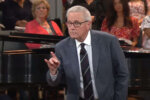
The world of stock car racing can be summed up in one word: speed. Everything happens fast. From the shop to the garage to the pit to the track—time (measured in hundredths of seconds) is literally money for those aspiring to NASCAR greatness. So, for rising-star driver Michael McDowell it’s no surprise that his spiritual transformation has been as rapid as his rise to prominence in the sport he loves.
In 2003 McDowell was balancing his desire to drive full time and trying to make a living as a newlywed when he lost a close friend—Ron Huber—who was also his employer and mentor. Huber’s passing served as “a reality check,” McDowell says, for what he was doing with his life. He was suddenly reminded by his friend’s death of the impact that Huber, a devoted Christian with strong ties to motorsports ministry, had quietly made in his life. Then, another employer named Tom Barnett brought real life into focus for McDowell.
“At Ron’s funeral, Tom asked me: ‘Where are you—what do you think about life after death?’” McDowell recalls. “He left it at that. Then God, working through all of that, led me to a relationship with Christ. It was at a church service with my wife’s uncle and aunt a little while later where I accepted Him. That’s when I really understood what grace and forgiveness was.”
Faith Takes the Lead
From there, McDowell did what comes natural for any race-car driver—he moved at breakneck speed into the challenge of growing in his faith. But he also applied equal amounts of energy to his burgeoning stock car career.
His love affair with racing started in Phoenix as an 8-year-old go-kart racer. Yet even before that, McDowell had gotten his first taste of racing by competing in a handful of BMX bike races—at the age of 3. The steady progression from his youth led him, he says, into Formula Car racing and what he thought was going to be a career as “an Indy Car driver.”
“I wanted to race Champ Car [a class of cars used primarily in the Indianapolis 500],” McDowell says. “But when the [Indy Car and Champ Car] series merged and they dissolved the Champ Car series, there weren’t a lot of opportunities for young Americans in open wheel [cars built with the wheels outside the auto’s main body].”
McDowell realized in 2007 that he had a better chance at long-term sustainability by switching his efforts to stock cars, although he had significant triumphs with open-wheel competition—including the 2004 Mazda Series championship and a pair of race wins in the Rolex Sports Car Series.
He worked his way up the stock car ranks, winning four races in the ARCA RE/MAX Series and receiving Rookie of the Year honors in 2007. Also, in three NASCAR Craftsman Truck Series races for Michael Waltrip Racing, McDowell was given “seat time”—the literal amount of time spent in the driver’s seat of a race car. It is especially important for a driver who is getting familiar with a new car or track.
And even though many of his contemporaries such as Justin Allgaier, Joey Logano, Brad Keselowski and Landon Cassill were moving into significant jobs with big name teams, McDowell was struggling to break into the top-tier Sprint Cup and Nationwide circuits.
But don’t expect the 26-year-old to complain or question his circumstances. McDowell remains grateful for the opportunities he’s been given and cherishes the relationships that have developed over time.
One such partnership was with MacDonald Motorsports, a family-owned and operated team led by people who share McDowell’s strong Christian convictions. McDowell drove the No. 81 Nationwide Series car. In 2010, he made 30 starts and finished a season-best 10th at Watkins Glen in New York.
The team was “extremely underfunded” and operated on “literally a tenth of the budget” of the top teams, he says. The car usually ran on used tires and older engines. But McDowell felt like God had brought him and Randy MacDonald, a former driver himself, together for a purpose.
On the Sprint Cup side, McDowell spent the 2010 season behind the wheel of the No. 46 car owned by Whitney Motorsports where he started 11 races, including the historic Daytona 500.
In 2011 McDowell will be driving the No. 66 car for HP Racing (formerly Prism Motorsports) in the Sprint Cup Series. He feels especially blessed for an opportunity to work with legendary car owner Joe Gibbs (Joe Gibbs Racing) for whom he will drive the famed No. 18 car at two Nationwide Series races in Iowa. Additional races may be in the works.
“These JGR race teams have an incredible performance history,” McDowell says. “I appreciate the confidence that [sponsor] Pizza Ranch and JGR have in me and I plan to make the best of it.”
Hitting the Wall at 170 mph
But to this day McDowell’s claim to fame is a moment that most race fans will never forget and one that he’d prefer to leave in the past.
It was April 4, 2008, at Texas Motor Speedway in Fort Worth. On qualifying day, two days before the Sprint Cup Samsung 500, McDowell was preparing to take Michael Waltrip Racing’s No. 00 car out for a two-lap run. The driver before him, David Reutimann, had blown his engine and left a sizable trail of oil. About 20 minutes later, after NASCAR had applied SpeedyDry to the track, McDowell raced off pit row trying to qualify in just his second Sprint Cup race.
“On my second lap, I got up in [the SpeedyDry] and the car got loose,” he says. “We’d actually pulled the brakes back just to have more speed, which in hindsight was probably a bad decision. I went to the brake and nothing was there, so I went to the other pedal, which is the gas, and turned to the right and the thing just took off and shot up the racetrack. As I was going up the racetrack, I knew it was going to be a very big impact.”
Race officials estimated that McDowell hit the wall at about 170 miles per hour. His car immediately caught fire and started to tumble—eight times, in fact, barrel-rolling down the track.
“As it was rolling, everything slowed down,” McDowell says. “It just got real still. It felt like it wasn’t going to stop. It just kept rolling and rolling and rolling. I didn’t know if I’d made it over the fence and I was on the other side of the racetrack. I didn’t know if I was going to land on a motor home in the infield because it felt like it took two or three minutes to stop.”
Miracle on Lap 2
McDowell’s car finally came to a stop on the apron. It had miraculously landed on its wheels. McDowell, who never lost consciousness throughout the ordeal, gave himself a quick layman’s exam, put the window net down and gingerly hopped out on his own power. NASCAR officials helped him limp slightly to the ambulance as the stunned crowd then burst into relieved applause.
In years past, when tracks didn’t have what is referred to as a “SAFER barrier” that uses foam to help reduce impact, McDowell’s impact could have easily caused death. Changes in the car also played a factor in saving his life. But McDowell, who was still a relatively new Christian at the time, knew he needed to publicly acknowledge his most powerful source of protection. “A lot of credit goes to the safety measures in the new car,” he says. “But I tell everyone that when you look at the wreck and you look at the car, it wasn’t the day that God chose for me to die. That’s really how I look at it.”
The accident not only underscored McDowell’s growing trust in the Lord, it also made him that much more thankful for his supportive wife, Jami, who was patiently and nervously waiting for him at the infield care center. The couple has been together since they were 15-year-old high school students in Arizona.
“We’ve gone through this whole process together—the struggles, the high points, the low points,” McDowell says. “Trying to break into this sport is extremely difficult. There are a lot of tough times through that process. She really gets it. She knows as much about the sport as I do. She understands how hard it is. Jami is that constant just like how God is always there. He’s always the same loving God. So having a spouse that’s in it with you is awesome.”
While appearing on The Ellen DeGeneres Show a few days after the accident, the host joked that Jami likely ordered her husband to get a desk job. But nothing was further from the truth. Ironically, Michael claims there are worse things in NASCAR than high-speed crashes lurking around Turn 1.
“This is a dangerous sport, but more so than that, it’s an easy sport to get trapped in and caught up in worldly things,” McDowell says. “There’s a lot of money and there’s a lot of fame. It’s sort of the rock star lifestyle.
“Just keeping yourself grounded in an environment that’s surrounded by worldly things is probably one of the biggest challenges. Putting your hope and trust and faith in Christ is the key.”
Chad Bonham is a veteran journalist-author and an aspiring film and broadcast producer with two documentaries to his credit. He lives in Broken Arrow, Okla., with his wife, Amy, and their three sons. He is currently working on three fall book releases, including The Faith of NASCAR.
Watch Michael McDowell’s miraculous escape, plus his interview with Ellen DeGeneres at mcdowell.charismamag.com
Faith in the Fast Lane
These NASCAR names aim for a higher track
Watch NASCAR on TV and you’ll notice something that separates the popular stock car races from just about any other sporting event at any level: a noticeable emphasis on faith. NASCAR’s commitment shines through the pre-race prayer and carries over into many of the drivers’ post-race interviews.

Shepherd’s ringing endorsement really isn’t a surprise—he’s the 69-year-old driver of the famous No. 89 “Jesus” car. But a growing number of his peers are also increasingly comfortable enough to wear faith on their sleeves—along with any number of sponsor patches.
Much of this public display traces back to NASCAR’s roots in the South, where the moonshine runners of the 1930s and 1940s who pioneered the sport were often faithful churchgoers. The tradition has continued, thanks to the NASCAR powers that be.

NASCAR’s broadcast partners are contractually required to televise all pre-race activities, including the prayer and the singing of the national anthem. But the real ministry takes place behind the scenes thanks to various organizations, such as Motor Racing Outreach (MRO).

“Our schedule never ends. It’s year-round,” legendary driver Mark Martin says. “There’s very little time off. That itself extracts an emotional price. MRO’s just been a really important part of my life for the last 20 years and something I can’t imagine what it would’ve been like without. It’s sort of like the anchor or the real foundation for you to build your life around.”
While NASCAR may have the most prevalent faith community throughout the expansive sports world, that doesn’t mean everyone in the garage buys into the message. That’s reason enough for up-and-coming driver Trevor Bayne to remain proactive in his approach.








Leave a Comment
You must be logged in to post a comment.